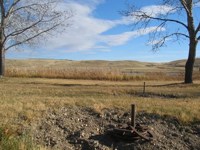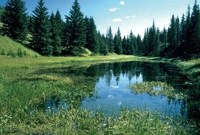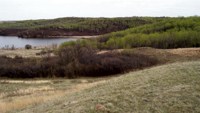Parks and Protected Areas
Conserving Biodiversity Under Climate Change
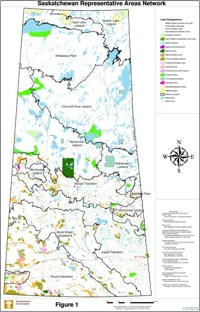
The Representative Areas Network (RAN) program established by Saskatchewan in 1997 encompasses an extensive system of parks and protected areas to conserve representative and unique examples of Saskatchewan's varied and diverse landscapes. One function of the RAN is to serve as ecological benchmarks and parks and protected areas can assist with monitoring for climate change.
Most protected areas have been designed to represent and protect specific natural features, species and communities, but have not taken into account the potential changes to ecosystems that could be induced by climate change. Some species may be eliminated from a given protected area as the climate becomes warmer or drier. Other species better adapted to warmer or drier climates may be prevented from migrating to the protected area because of the absence of migration corridors.
What You Should Know
The Future Climate:
- Saskatchewan's climate is expected to be:
- warmer
- drier
- more variable and
- experience more frequent and more intense extreme events (e.g. heavy precipitation and drought).
- Precipitations patterns will change -likely wetter, earlier springs and drier summers
- Droughts will likely increase in intensity and frequency
- The growing season is expected to:
- be longer
- start earlier
- be warmer
- have an overall increase in accumulated heat units.
Anticipated Impacts on Parks and Protected Areas:
- Climate change exacerbates other biodiversity threats including habitat loss and fragmentation, pollution, and invasive species
- Resilience to climate change will depend on the protected area's size, surrounding land uses, linkages with other natural landscapes and management regimes.
- vegetation zones are expected to shift northward considerably by 2050:
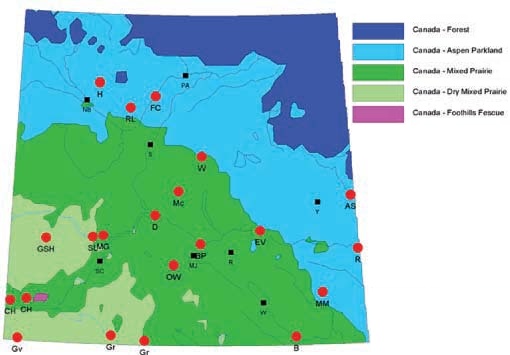
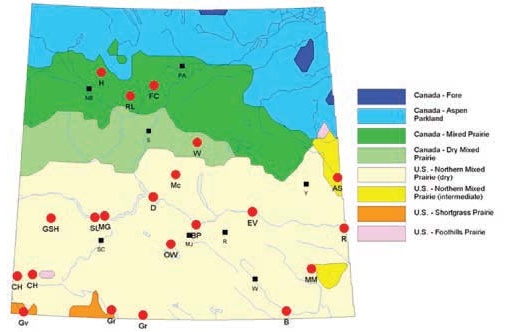
Predicted vegetation zones in southern Saskatchewan in the 2050s under CSIROMk2b B11 scenario
| AS | Assiniboine Slopes Ecological Reserve | Gv | Govenlock Community Pasture |
| B | Buffalograss Ecological Reserve | H | Hatherleigh Community Pasture |
| BP | Buffalo Pound Provincial Park | Mc | McCraney Community Pasture |
| CH | Cypress Hills Provincial Park (West Block and Centre Block) | MG | Matador Grasslands Provincial Protected Area |
| D | Douglas Provincial Park | MM | Moose Mountain Provincial Park |
| EV | Echo Valley Provincial Park | OW | Old Wives Community Pasture |
| FC | Fort Carlton Provincial Park | R | PCS Rocanville (private stewardship area) |
| FW | Fort Walsh National Historic Site | SL | Saskatchewan Landing Provincial Park |
| Gr | Grasslands National Park (West Block and East Block) | W | Wolverine Community Pasture |
| GSH | Great Sand Hills Ecological Reserve (proposed) |
Case study areas, with abbreviations used on vegetation zonation maps
- The southern boreal forest will have a climate more suitable for aspen parkland
- Current aspen parkland will shift toward open grassland.
- Southern grassland will shift toward a mixed prairie currently found in the northern US.
- For the Prairie Ecozone there will be a decrease of midgrasses and an increase in shortgrasses; a decrease in cool-season grasses and an increase in warm-season grasses; and a decrease in tree growth. Grassland production loss may be moderated by the increase in warm-season grasses, which utilize water more efficiently.
- For Cypress Hills and Moose Mountain Provincial Parks, Wolverine PFRA Pasture, and Assiniboine Slopes Ecological Reserve expect a gradual reduction of tree and shrub cover; a decrease in animal species that are dependent on woody cover; and along with an increase in grassland species and animal and plant species currently found only in the U.S.
- For the Great Sand Hills Ecological Reserve and Douglas Provincial Park, there will be an increased potential for dune activation.
- In Moose Mountain Provincial Park, water bodies are expected to shrink as ponds are replaced by wetlands, and wetlands are invaded by forest.
Moving Forward - Adaptation Options:
- Climate change adaptation needs to be a consideration of planning at not only the site level but also from the system perspective (e.g. connectivity among sites within the RAN).
- There should be overarching policy and legislation guiding resource management of all sites within the RAN and access to resources to ensure climate change is addressed.
- Individual sites should:
- be actively managed to minimize threats to biodiversity (overuse, pesticides and pollution, habitat loss and fragmentation) and incorporate climate change consideration in management planning
- undertake a review of active management activities (endangered species protection, fire protection including reducing fuel loads, controlled burns, exotic species management, maintain a diversity of age stands in the forest) in light of climate change and determine if changes are necessary.
- respond aggressively to pathogen disturbances; actively regenerating the existing forest; and, if appropriate, consider introducing exotic tree species better adapted to the new climate parameters
- choose restoration species or varieties based on adaptation to future climate, rather than recreating historic plant communities
- protect wetland sites especially, as they are most threatened
- zoning (applying different management techniques to different parts of a protected area) is a valuable tool for coping with climate change
- high relief sites (like Cypress Hills) will always have high biodiversity, though the nature of the species mix may change.
Sources:
- Froese, D. et al, editors (2008): Protected Area Policies and Climate Change: The Case of the Prairie Ecozone, Saskatchewan. PARC Summary Report No. 08-02, pp. 15
- Henderson, N. et al (2002): Climate Change Impacts on the Island Forests of the Great Plains and the Implications for Nature Conservation Policy; The Outlook for Sweet Grass Hills (Montana), Cypress Hills (Alberta - Saskatchewan), Moose Mountain (Saskatchewan), Spruce Woods (Manitoba) and Turtle Mountain (Manitoba - North Dakota); Prairie Adaptation Research Collaborative, Regina, Saskatchewan, 116 p.
- Saskatchewan Environment (2004): Saskatchewan Representative Areas Network Map.
- Saskatchewan Environment (2005): RAN Saskatchewan Representative Areas Network Progress Report 2005. [accessed March 17, 2010]
- Scott, D. and Lemieux, C. (2005): Climate Change and Protected Area Policy and Planning in Canada. The Forestry Chronicle 81(5 September/October), p. 696-703.
- Vandall, J.P. et al (2006): Suitability and Adaptability of Current Protected Area Policies under Different Climate Change Scenarios: The Case of the Prairie Ecozone, Saskatchewan; Saskatchewan Research Council, Publication 11755-1E06, 117 p.
